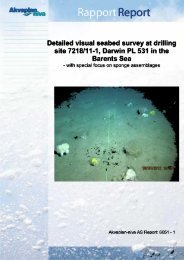A study of the priority substances of the Water Framework Directive ...
A study of the priority substances of the Water Framework Directive ...
A study of the priority substances of the Water Framework Directive ...
You also want an ePaper? Increase the reach of your titles
YUMPU automatically turns print PDFs into web optimized ePapers that Google loves.
26 Pentachlorobenzene<br />
� Pentachlorobenzene is very toxic to aquatic<br />
organisms, persistent and bioaccumulates.<br />
� There is little registered use in Norway, but<br />
pentachlorobenzene is a metabolite <strong>of</strong> Lindane.<br />
� Monitoring should be done toge<strong>the</strong>r with<br />
Lindane.<br />
Production and use<br />
Globally, pentachlorobenzene is known as an<br />
intermediate in <strong>the</strong> production <strong>of</strong> <strong>the</strong> fungicide<br />
quintozene, as a flame retardant and as a contaminant<br />
<strong>of</strong> hexachlorobenzene which has been<br />
used as a fungicide. The substance has also been<br />
used with PCB. There is little registered use in<br />
EU. Pentachlorobenzene is not registered in <strong>the</strong><br />
Norwegian Product Register. Quintozene (sometimes<br />
registered in Norway as Kvintosen) has<br />
been in use, data show use from 1974 until <strong>the</strong><br />
fungicide lost its license from 1987. From 700<br />
to almost 5000 kilos were sold per year.<br />
Emissions, discharges,<br />
distribution and hot-spots<br />
Pentachlorobenzene may have been present in<br />
discharges from Falconbridge in Kristiansand<br />
and from <strong>the</strong> Magnesium production plant at<br />
Herøya. Contamination from Quintozene is<br />
possible, but <strong>the</strong>re is no information available.<br />
As <strong>the</strong> substance is a metabolite <strong>of</strong> Lindane, it<br />
may be found in areas polluted with Lindane,<br />
especially due to its high persistence and tendency<br />
to accumulate in fish.<br />
Monitoring<br />
Pentachlorobenzene has been monitored in several<br />
studies in Norway.<br />
Marine sediment<br />
Pentachlorobenzene was earlier part <strong>of</strong> <strong>the</strong> monitoring<br />
programs for <strong>the</strong> fjords outside <strong>the</strong> magnesium<br />
production plant at Herøya and <strong>the</strong><br />
nickel smelter Falconbridge in Kristiansand. The<br />
concentrations found were low.<br />
In a <strong>study</strong> from Sandefjordsfjorden and Indre<br />
Mefjorden, low concentrations <strong>of</strong> pentachlorobenzene<br />
were found in one sample from<br />
<strong>the</strong> inner parts.<br />
FACTS<br />
Cas no.: 608-93-5<br />
pentachlorobenzene ::::::::::..<br />
Synonyms: Pentaklorbensen, PeCB; 1,2,3,4,5-pentachlorobenzene,<br />
5CB, PCBz<br />
Properties: Colourless needles, pleasant odour.<br />
Toxic effects: Commercial pentachlorobenzene is an<br />
irritant and slightly toxic. Acute LD50 rat oral is 1000-<br />
1125 mg/kg. It may cause liver and kidney damage.<br />
The substance is very toxic to aquatic organisms<br />
(ClassLab). LC50 guppy (Poecilia reticulata) 0,178<br />
ppm/14 days and LC50 Daphnia magna 4,1-7,2<br />
mg/l/48 h. Lowest concentration with observed<br />
effect on snails and mussels is 0,04 mg/l<br />
(Naturvårdsverket).<br />
Log Kow: 4,8 - 5,18<br />
Persistence: Atmospheric half-life for pentachlorobenzene<br />
is about 277 days (Hydroxyl radicals).<br />
Half life in soil is 200-350 days (lab, HSDB). In<br />
water half life depends on amounts <strong>of</strong> solids, from<br />
194 to 1250 days (Swedish EPA). 41 % photodegradation<br />
is registered in surface waters in 24 hours. Under<br />
field conditions <strong>the</strong> strong adsorption to solids may<br />
counteract <strong>the</strong> photodegradation (CIRCA).<br />
Bioconcentration in aquatic organisms is very high.<br />
<strong>Water</strong> solubility: 0,56 mg/l at 20°C<br />
Molecular formula: C 6 HCl 5<br />
Metabolites: pentachlorophenol, tetrachlorophenol<br />
(2,3,4,5-tetrachlorophenol, 2,3,4,6-tetrachlorophenol,<br />
1,2,3,4-tetrachlorobenzene, 1,2,4,5-tetrachlorobenzene,<br />
1,2,3,5-tetrachlorobenzene, 2,3,4-trichlorphenol,<br />
2,4,6-trichlorphenol, 3,4,5-trichlorphenol, 1,3,5trichlorbenzene).<br />
Fresh water biota<br />
In a <strong>study</strong> <strong>of</strong> fish downstream three municipal<br />
landfills in Eastern Norway, pentachlorobenzene<br />
was found in samples <strong>of</strong> pike (Esox lucius) liver<br />
and perch (Perca fluviatilis) liver. The levels<br />
were low.<br />
Need for fur<strong>the</strong>r screening and monitoring<br />
There is no need for a screening <strong>of</strong> pentachlorobenzene,<br />
but <strong>the</strong> substance should be<br />
investigated in connection with Lindane monitoring.<br />
A <strong>study</strong> <strong>of</strong> <strong>the</strong> <strong>priority</strong> <strong>substances</strong> <strong>of</strong> <strong>the</strong> <strong>Water</strong> <strong>Framework</strong> <strong>Directive</strong><br />
TA-2140/2005<br />
63:::..

















